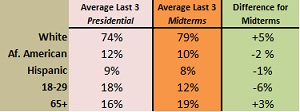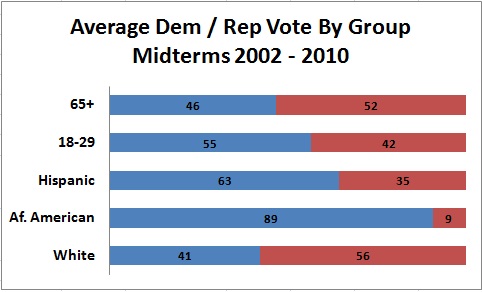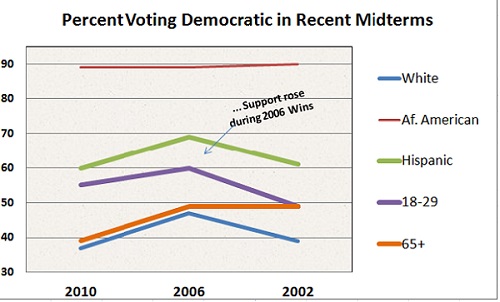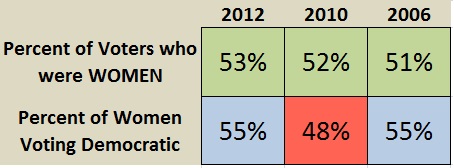The Democrats' demographic dilemma
In 2012 we made much of the Democrats’ turnout advantage: the idea that “demographics is destiny” and that a base of young, increasingly diverse voters was tilting the whole playing field their way. But unlike presidential years, midterms hold a particular challenge for Democrats in rallying that base.
So when Democratic House members - well, the ones who could make it through last week’s storm, anyway - gathered at their annual retreat to talk midterm strategy, it was no surprise the focus was on economic issues - minimum wage; inequality; unemployment - of top concern to that base. Alongside their much-vaunted “big data” vote-targeting, it’s clear they hope to make history this year by, in a sense, repeating it -- or, as the New York Times reported, trying to make 2014’s turnout look more like 2012’s.
But it won’t be easy.
First, the backstory: fewer people vote in midterms for House and Senate control than in presidential races – about 40 million fewer in the last cycle; or just 41 percent turnout compared to 58 percent. Reasons abound: not every state has a hot race to decide; attention can wane as midterms lack the national spotlight of a presidential race, with its conventions and barnstorming, or a compelling single character to follow. There can be a one-sided sense of urgency, too, for the party “out” of power (that is, not in the White House) who see a foil in an opposing president, which also helps explain why presidents’ parties have historically fared poorly.
This turnout difference doesn’t always affect each side evenly, though: midterm electorates have been a little older and more conservative, and have more white than minority voters compared to presidential years, which these days means groups that lean Republican are showing up more.
This chart shows the average differences between presidential year turnout and midterm turnout for the last three cycles. None of these may look like huge differences at first glance, ranging from 1 to 6 points, but in a big country a few percent adds up to millions of votes; and in a closely-divided one, that counts a lot.
Those average margins for Republicans are actually not consistently large year to year; Democrats did much better in winning the votes of both whites and older voters in 2006, when they won the House, but also did even better with young voters, demonstrating the point that just “winning” a group isn’t often enough, and doing better usually means winning more of them than usual.
Here are the voting breakdowns by individual year.
However, it has also gotten a little older (21 percent in 2010 up from 18 percent in 2002) and the percent of voters under 30 has only gone up a smidge. All told, probably a mixed bag for Democrats.
This is especially important given the landscape we’re looking at in 2014. On the Senate side, at least, the competitive map has a lot of states with a lot of older voters and comparably less diversity – in particular, fewer Hispanic voters - in the first place. In other words, a lot of these demographic groups aren’t there to turn out anyway. For instance, Arkansas - one of the year's key battlegrounds - was 83 percent white and just 2 percent Hispanic in 2010 and – importantly – was far older, at 32 percent over 65, than the national average of 21 percent 65-plus. Kentucky was 90 percent white, 2 percent Hispanic. And for the House, the Hispanic vote could impact some of the races in California or Arizona, but many of the (few) competitive seats are less diverse.
Lastly, let’s turn to the women’s vote. Democrats won women in 2012 and are sure to once again make a 2014 push on womens’ issues. But here again, we have a demographic that might lean Democratic, but it will require both persuasion and differential turnout for Democrats to succeed.
The percent of women who turn out doesn’t really vary much. But when Democrats do well, they do win more of them. Or maybe it’s better to say when Democrats do well with women, they win.
Democrats’ successful 2006 (and for that matter 2008) congressional campaign was not marked by some unusually high overall turnout among women. Rather, more women voted Democrat.





